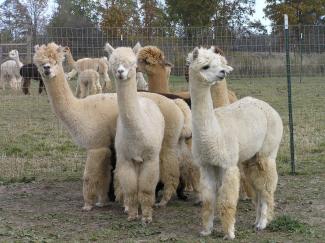
Instructions
Do the preparation exercise before you listen. Then do the other exercises to check your understanding.
Preparation
Do this exercise before you listen.
Transcript
Zoo guide: OK, are we all together? Right, next we're going to look at the llamas, but actually here we have four different animals which are all from South America and all related to camels. Llamas, which you have probably heard of, over here. And over there alpacas, vicuñas and guanacos.
Llamas and alpacas are both domesticated animals and vicuñas and guanacos are wild. Llamas are the biggest animal – they can grow up to 1.8 metres tall and in the past they were used to carry things. Llamas are very sociable animals and live together in groups, in herds.
Teenager 1: Don't they spit at people, though?
Guide: Well, yes, they can. All members of the camelid family sometimes spit. You don't want to mistreat a llama; it might even spit some of the contents of its stomach at you.
Group of teenagers: Uuuugggh!
Guide: But if you treat them properly they are not likely to. They respond well to being trained and they are usually gentle and curious.
OK, over here we have the alpacas. As you can see, they are smaller than the llamas. They've got smaller faces and they always look as though they are smiling. Look at this one's face.
Group of teenagers: Aaaah!
Guide: The alpaca is famous for its wool, which is softer and warmer than sheep's wool. There's a big demand for alpaca wool from the fashion industry.
Right, next to the alpacas we have the vicuñas. As I said before, these animals are wild and they are thought to be the ancestors of the alpacas. Vicuñas are very elegant and graceful creatures. Look at this one. She's beautiful.
Group of teenagers: Mmmm. She's lovely.
Guide: Have you heard of the Incas? The ancient rulers of Latin America who lived in the Andes? Well, they wore clothes made from vicuña wool – only the royal family were allowed to wear the wool. It is even softer than alpaca wool but vicuñas can only be shorn of their wool every three years. For that reason the wool's very expensive.
And, lastly, we have the guanacos. They are similar to the vicuñas, but larger and stronger. They are capable of surviving at over 4,000 metres in the Andes. When they are in the desert they survive by licking the water off the cacti and other desert plants. Right, any questions?
Teenager 2: I think I can hear this llama making a noise.
Guide: Ah, yes. That could be the llama humming. They don't open their mouths, they just make this strange noise. They hum when they are stressed, or the opposite, feeling relaxed.
Teenager 1: Can llamas live in the UK?
Guide: Yes, there are quite a lot of llamas and alpaca in the UK. They adapt very well to our climate. They make good pets and sometimes they're used for trekking. You go on a picnic and use a llama to carry your food.
Teenager 3: Cool! I want to do that!
Guide: And sometimes farmers use them as guard dogs, I mean guard llama. The adult males will protect sheep and hens from animals that might attack them, like dogs or foxes. They're really useful animals.
What's your favourite wild animal? Why?

Comments